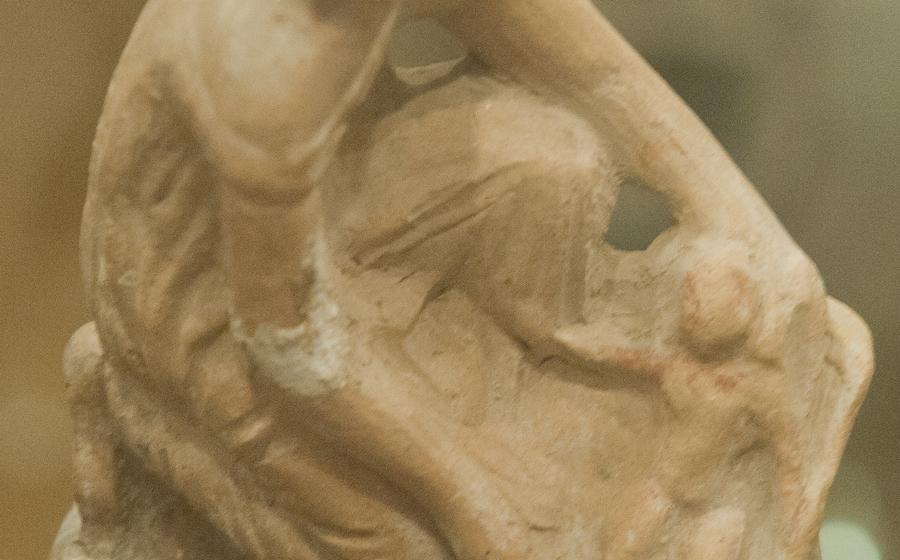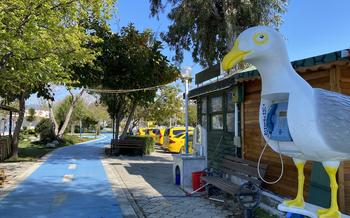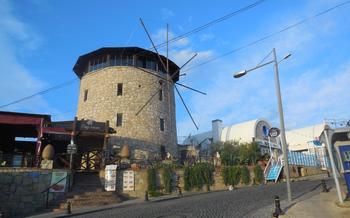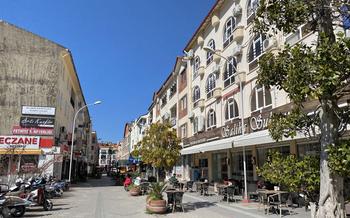
Bodrum Ancient Shipyard
- The Antiquity of Bodrum’s Shipyard
- Maritime Heritage Museum
- Shipbuilding and Restoration
- Ancient Shipbuilding Techniques
- Shipyard's Role in Ancient Trade
- Interactive Workshops
- Shipyard's Contribution to Bodrum's Tourism
- Shipyard's Architectural Features
- Shipyard's Connection to the Sea
- Shipyard's Role in Naval History:
- Shipyard's Contribution to Education
- My Personal Experience with Maritime Education at the Shipyard
- Shipyard's Future Plans
- Historical Figures Associated with the Shipyard
- Local Legends and Folklore
- Insider Tip:
The Antiquity of Bodrum’s Shipyard
The ancient city of Bodrum, situated in the picturesque Turkish province of Muğla, boasts a rich maritime history that dates back to antiquity. Archaeological excavations have unearthed remarkable remnants of a shipyard that once served as a prominent hub for shipbuilding and trade. The discovery of these ancient structures, including slipways, workshops, and storage facilities, has provided invaluable insights into the advanced shipbuilding techniques and maritime prowess of ancient civilizations.
The Bodrum Shipyard, with its strategic location on the Aegean Sea, played a pivotal role in the development of naval traditions and maritime commerce throughout the Mediterranean region. Its proximity to major trade routes facilitated the exchange of goods and ideas between diverse cultures, leaving an indelible mark on the region's cultural and economic landscape. Over the centuries, the shipyard witnessed the evolution of shipbuilding techniques, from rudimentary boat construction to the development of sophisticated vessels capable of navigating the vast seas.
The shipyard's legacy extends beyond its physical remains, embodying the ingenuity and craftsmanship of ancient shipbuilders. The study of these ancient techniques, tools, and materials has shed light on the remarkable skills and knowledge possessed by our ancestors. Through the preservation and exploration of the Bodrum Shipyard, we gain a deeper understanding of the maritime heritage that continues to shape the identity of this vibrant coastal city.
Maritime Heritage Museum
The Maritime Heritage Museum, nestled within the Bodrum Ancient Shipyard, is a captivating showcase of the region's rich maritime history. As you step through its doors, you'll be greeted by an array of captivating exhibits and artifacts that narrate the captivating tales of ancient seafaring traditions. From meticulously preserved shipwrecks to intricately crafted navigational instruments, each artifact holds a story of adventure, exploration, and cultural exchange.
The museum's interactive displays provide an immersive experience, allowing you to delve into the world of ancient mariners. Touchscreens and multimedia presentations bring to life the shipyard's shipbuilding techniques, the challenges faced by sailors on the open seas, and the pivotal role that Bodrum played in shaping the maritime landscape of the Mediterranean.
As you wander through the museum's galleries, you'll feel a tangible connection to the past. Imagine the bustling atmosphere of the shipyard centuries ago, as skilled craftsmen meticulously constructed vessels that would embark on epic voyages across the Mediterranean Sea. The Maritime Heritage Museum is not just a repository of artifacts; it's a living testament to the enduring spirit of exploration and innovation that has defined Bodrum's maritime heritage.
Shipbuilding and Restoration
The Bodrum Ancient Shipyard is not only a testament to the ingenuity of ancient shipbuilders but also a living example of their craft. Traditional shipbuilding methods are still practiced, and visitors can witness the painstaking process of restoring ancient vessels to their former glory.
The shipyard's craftsmen use the same tools and techniques as their ancestors, relying on traditional knowledge and experience. They skillfully shape wooden planks into sleek hulls, meticulously attach them with wooden dowels, and waterproof the seams with natural materials.
Preserving maritime heritage and craftsmanship is a crucial aspect of the shipyard's work. The restoration process involves extensive research and collaboration with historians and archaeologists to ensure the authenticity and accuracy of the reconstructed vessels.
The shipyard's challenges lie in balancing the preservation of ancient techniques with the need for innovation and adaptation to modern safety standards. However, the dedication and expertise of the craftsmen have resulted in several successful restorations, showcasing the resilience and longevity of traditional shipbuilding practices.
Ancient Shipbuilding Techniques
The ancient shipbuilding techniques used at Bodrum's Ancient Shipyard demonstrate the ingenuity and craftsmanship of the past. Traditional tools like chisels, hammers, and adzes were employed to shape wooden planks, which were then joined using wooden pegs and dowels. The shipyard's craftsmen possessed a deep understanding of the local timber's properties, selecting durable woods like oak, cedar, and cypress for their shipbuilding endeavors.
The construction process began with the creation of the ship's keel, which formed the backbone of the vessel. The planks were then attached to the keel using wooden pegs, creating a sturdy and watertight hull. The shipyard's craftsmen also employed advanced techniques like caulking and waterproofing to ensure the ship's longevity and resistance to harsh sea conditions.
These traditional shipbuilding techniques stand in stark contrast to modern practices, which often rely on prefabricated components and advanced machinery. The ancient methods required a high level of skill and precision, as each ship was meticulously handcrafted by experienced artisans. This attention to detail resulted in vessels that were not only functional but also aesthetically pleasing, showcasing the artistry of the ancient shipbuilders.
One of the most fascinating aspects of the ancient shipbuilding techniques is the use of mortise-and-tenon joints. These joints, created by inserting a protruding tenon into a corresponding mortise, provided a strong and flexible connection between the planks. This technique allowed the ships to withstand the rigors of long sea voyages and heavy loads.
The ancient shipbuilders of Bodrum also displayed a remarkable understanding of hydrodynamics. The shape and design of their vessels were carefully crafted to optimize speed and maneuverability. The hulls were often sleek and streamlined, with a narrow beam and a deep draft, allowing the ships to cut through the water with ease.
These ancient shipbuilding techniques, with their emphasis on craftsmanship, ingenuity, and a deep understanding of materials, continue to inspire modern shipbuilders and maritime enthusiasts alike. The Bodrum Ancient Shipyard serves as a living testament to the skill and artistry of the ancient shipbuilders, showcasing the rich maritime heritage of this region.
Shipyard's Role in Ancient Trade
The ancient shipyard of Bodrum played a pivotal role in facilitating maritime trade throughout the Mediterranean and beyond. Strategically positioned at the crossroads of major sea routes, the city served as a hub for the exchange of goods and ideas between civilizations. Historical accounts and archaeological discoveries attest to the bustling trade activities that took place within the shipyard's confines.
In the heyday of the ancient world, ships laden with precious cargo, such as silks, spices, and pottery, would dock at Bodrum's shipyard. Merchants from far-off lands bartered and negotiated, exchanging their wares for local products, fostering cultural exchange and economic prosperity. The shipyard was not merely a center for commercial transactions; it was a meeting point of diverse cultures, where people of different ethnicities and backgrounds intermingled, shaping the course of history.
The strategic significance of Bodrum's shipyard in ancient trade routes cannot be overstated. It served as a gateway to the Aegean Sea, the Black Sea, and the Eastern Mediterranean, connecting the civilizations of Greece, Rome, Egypt, and the Near East. Through its bustling trade activities, Bodrum played a crucial role in disseminating cultural influences, technological advancements, and artistic traditions, leaving an indelible mark on the development of the ancient world.
Interactive Workshops
The Bodrum Ancient Shipyard offers a unique opportunity for visitors to delve deeper into the art of ancient shipbuilding through interactive workshops. These hands-on experiences allow participants to learn traditional techniques, work with authentic materials, and create their own miniature replicas of ancient vessels.
The shipyard's skilled craftsmen guide visitors through the entire process, from selecting the appropriate wood to shaping the hull and assembling the various components. Participants gain insights into the ingenuity and precision that went into constructing these ancient seafaring marvels.
Attending a workshop is not just an educational experience; it's a journey back in time that fosters a deeper appreciation for the craftsmanship and maritime heritage of the ancient world. The workshops are suitable for people of all ages and skill levels, making them a perfect activity for families, couples, or solo travelers seeking a truly immersive experience.
The workshops are also an excellent way to connect with the local community and learn about their ongoing efforts to preserve traditional shipbuilding techniques. By participating in these workshops, visitors contribute to the revitalization of this ancient craft and help ensure its legacy continues for generations to come.
Shipyard's Contribution to Bodrum's Tourism
The Bodrum Ancient Shipyard has emerged as a significant tourist attraction, drawing visitors from around the world. Its historical significance and unique architectural features make it a must-visit destination for anyone interested in maritime history and culture. The shipyard's transformation into a museum has further enhanced its appeal, providing visitors with an immersive experience into the world of ancient shipbuilding.
The shipyard's contribution to Bodrum's tourism industry is substantial. It has become a key player in attracting tourists to the region, generating revenue and creating job opportunities for locals. The shipyard's presence has also contributed to the development of Bodrum's tourism infrastructure, leading to the establishment of hotels, restaurants, and other tourist-related businesses.
As a visitor to the shipyard, I was struck by its ability to transport me back in time. The preserved ancient vessels, the interactive exhibits, and the knowledgeable guides all contributed to a truly engaging and educational experience. The shipyard's strategic location, nestled along the picturesque Bodrum coastline, further adds to its allure, making it a popular spot for tourists to explore and capture stunning photographs.
Overall, the Bodrum Ancient Shipyard stands as a testament to the region's rich maritime heritage while simultaneously contributing to its present-day tourism success. Its unique blend of history, culture, and education makes it a must-visit destination for anyone seeking an unforgettable travel experience.
Shipyard's Architectural Features
The Bodrum Ancient Shipyard showcases unique architectural features that reflect its historical significance and functionality. Constructed in the 4th century BC, the shipyard exhibits remarkable engineering and design principles. Its layout comprises a series of arched vaults and chambers carved into the surrounding rock formations. These vaults served as dry docks, providing protection for ships during construction and repair. The shipyard's strategic location, sheltered from strong winds and currents, further contributed to its efficiency and safety.
The construction techniques employed in the shipyard demonstrate the ingenuity and craftsmanship of its ancient builders. The vaults and chambers were meticulously carved using hand tools and without the aid of modern machinery. The use of local stone and mortar ensured durability and resilience against the elements. The shipyard's design also incorporated sophisticated water management systems, including channels and reservoirs, to regulate water levels within the dry docks.
The shipyard's architectural heritage holds immense significance in understanding ancient shipbuilding practices and maritime engineering. Its well-preserved state offers a glimpse into the remarkable achievements of ancient civilizations and their mastery of naval architecture. Exploring the shipyard's unique features provides visitors with a tangible connection to the past and a deeper appreciation for the skills and dedication of ancient shipbuilders.
Shipyard's Connection to the Sea
The Bodrum Ancient Shipyard has an inseparable bond with the sea, a relationship that has shaped its history, culture, and identity. From its inception, the shipyard has been inextricably linked to the maritime world, serving as a birthplace for countless vessels that sailed the Aegean Sea and beyond.
In ancient times, Bodrum was a major port city, and the shipyard played a crucial role in trade and commerce. Ships built here carried precious goods and facilitated cultural exchange between civilizations. The sea was the shipyard's lifeblood, providing the raw materials, the means of transportation, and the inspiration for its artisans.
The shipyard's location, nestled between the azure waters of the Aegean and the protective embrace of the surrounding mountains, further underscores its connection to the sea. The shipyard's workers, with their weathered faces and salt-stained hands, have always looked to the sea as their muse and their master.
Even today, the shipyard remains deeply connected to the sea. The Maritime Heritage Museum showcases fascinating exhibits that tell the story of Bodrum's maritime past, while the shipyard's workshops continue to produce beautiful replicas of ancient vessels. Visitors can witness the intricate process of shipbuilding, marveling at the skill and dedication of the craftsmen who breathe life into these wooden giants.
The shipyard's connection to the sea is more than just a physical one; it is a spiritual and cultural bond that has endured for centuries. The sea is the shipyard's heritage, its identity, and its destiny.
Shipyard's Role in Naval History:
The Bodrum Ancient Shipyard holds a significant place in naval history, serving as a crucial hub for shipbuilding and playing a pivotal role in shaping maritime battles and conflicts. During the reign of the mighty Ottoman Empire, the shipyard was instrumental in constructing and maintaining a formidable fleet that commanded respect and power across the seas. Historical accounts narrate the shipyard's involvement in famous naval engagements, including the legendary Battle of Lepanto in 157The shipyard's contributions to naval prowess extended beyond its shipbuilding prowess; it also served as a training ground for skilled sailors and navigators, ensuring the Ottoman Empire's maritime dominance. The legacy of the shipyard in naval history continues to captivate visitors, inviting them to explore the stories of bravery, strategy, and maritime power that unfolded within its walls.
Shipyard's Contribution to Education
The Bodrum Ancient Shipyard has played a crucial role in maritime education and research throughout history. In the past, it served as a training ground for aspiring shipbuilders and seafarers, offering apprenticeship programs that passed down traditional shipbuilding skills and knowledge from generation to generation. These apprenticeships provided hands-on experience in all aspects of shipbuilding, from woodworking and metalworking to rigging and sailing. The shipyard also served as a research center, where naval architects and engineers experimented with new ship designs and technologies. Today, the shipyard continues to be a center for maritime education, hosting workshops, seminars, and conferences on various aspects of shipbuilding and maritime history. The shipyard's museum also serves as an educational resource, showcasing the evolution of shipbuilding techniques and the rich maritime heritage of the region. By preserving traditional shipbuilding skills and promoting maritime education, the Bodrum Ancient Shipyard plays a vital role in ensuring that the legacy of this ancient craft continues to thrive for generations to come.
My Personal Experience with Maritime Education at the Shipyard
During my visit to the Bodrum Ancient Shipyard, I had the opportunity to participate in a hands-on workshop on traditional shipbuilding techniques. Under the guidance of experienced craftsmen, I learned about the tools and materials used in ancient shipbuilding and tried my hand at various tasks, such as woodworking, rope making, and sail rigging. The workshop provided a unique and immersive experience that allowed me to gain a deeper understanding of the skills and craftsmanship involved in building ancient ships. It was fascinating to learn about the ingenuity and precision of the ancient shipbuilders and to see how their techniques have been preserved and passed down over the centuries.
Shipyard's Future Plans
The Bodrum Ancient Shipyard is committed to preserving its rich legacy for future generations. Ongoing restoration and conservation efforts aim to maintain the shipyard's structural integrity and authenticity. Plans are underway to expand the museum and facilities, creating more space for exhibits, workshops, and educational programs. The shipyard's future vision includes becoming a leading center for maritime research and education, promoting the preservation of traditional shipbuilding skills and the exploration of new technologies. By embracing innovation while staying true to its roots, the Bodrum Ancient Shipyard will continue to captivate visitors and contribute to the preservation of Turkey's maritime heritage.
Historical Figures Associated with the Shipyard
Throughout history, the Bodrum Ancient Shipyard has welcomed numerous influential figures who left their mark on its legacy. One such individual was the renowned naval commander, Cengiz Han, who frequented the shipyard during his campaigns in the Mediterranean Sea. His strategic insights and expertise in naval warfare played a vital role in shaping the shipyard's development.
Another notable figure associated with the shipyard was the famed Admiral Piri Reis, a skilled navigator and cartographer. His contributions to maritime exploration and mapmaking were significant, and his association with the shipyard added to its reputation as a hub of maritime knowledge.
The shipyard also attracted the attention of prominent European explorers and adventurers. In the 16th century, the French explorer Jacques Cousteau visited the shipyard and conducted extensive research on the ancient shipbuilding techniques used there. His findings shed light on the shipyard's historical significance and contributed to the preservation of its legacy.
These historical figures, among many others, have left an indelible mark on the Bodrum Ancient Shipyard. Their contributions and experiences have shaped the shipyard's narrative, making it a site of both historical and cultural importance.
Local Legends and Folklore
The Bodrum Ancient Shipyard is steeped in local legends and folklore, passed down through generations of seafarers and shipyard workers. One captivating tale speaks of a legendary shipbuilder named Ustah Yusuf, whose craftsmanship was said to be blessed by the sea gods themselves. It is believed that Ustah Yusuf's ships possessed an uncanny ability to navigate treacherous waters and always return home safely, no matter the storms they encountered.
Another tale tells of a mysterious treasure hidden within the shipyard's depths, said to be guarded by the spirits of ancient sailors. Legend has it that the treasure was buried by a wealthy merchant who sought to protect his riches from invading forces. Many have attempted to find the treasure, but none have succeeded, as the shipyard's spirits are said to fiercely protect their secrets.
These legends and stories add a touch of magic and intrigue to the Bodrum Ancient Shipyard, capturing the imagination of visitors and locals alike. They serve as a testament to the shipyard's rich history and cultural significance, weaving a tapestry of myth and reality that further enhances its allure.
Insider Tip:
Visiting the Bodrum Ancient Shipyard during the spring or fall offers a more pleasant climate and fewer crowds. Remember to wear comfortable shoes as you'll be doing a lot of walking on uneven surfaces. To fully immerse yourself in the shipyard's history, consider joining a guided tour led by a local expert. They can provide insights and anecdotes that bring the shipyard's past to life.
After exploring the shipyard, indulge in the local cuisine at one of the many restaurants in Bodrum. Sample fresh seafood dishes accompanied by traditional Turkish mezze. To extend your stay and delve deeper into the region's maritime heritage, consider visiting the nearby Bodrum Maritime Museum, which showcases an impressive collection of artifacts and exhibits related to the town's rich seafaring history.









